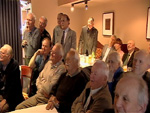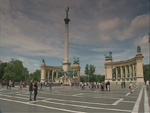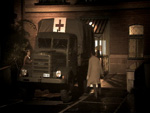 Miklos Gratzer was 22 years old when the fighting broke out. He was a fourth-year forestry student at Sopron University in the wooded hills near the Austrian border. His roommate, Istvan Tolnai, commanded the brigade of students who immediately took control of the border crossing at Sopron.
Miklos Gratzer was 22 years old when the fighting broke out. He was a fourth-year forestry student at Sopron University in the wooded hills near the Austrian border. His roommate, Istvan Tolnai, commanded the brigade of students who immediately took control of the border crossing at Sopron.
As fighting escalated in the capital city of Budapest, hospitals were quickly overwhelmed and in desperate need of supplies. Gratzer and one of his buddies commandeered a three-ton truck from a local textile factory. They raced toward the city along back roads through a darkening chaos with the first load of blood plasma. Just after midnight they got stopped at a Soviet army roadblock…
 …The next afternoon, in another part of Budapest, 12-year-old Anna Porter met the enemy. She crouched in a doorway only a few blocks from the Danube. With a pocket full of bullets and a long black rifle in her hands, she watched a Russian soldier crawl from the burning wreckage of his tank and stagger towards her…
…The next afternoon, in another part of Budapest, 12-year-old Anna Porter met the enemy. She crouched in a doorway only a few blocks from the Danube. With a pocket full of bullets and a long black rifle in her hands, she watched a Russian soldier crawl from the burning wreckage of his tank and stagger towards her…
The revolution began the afternoon of October 23 rd, 1956, as a placard-waving crowd of students and factory workers swarmed the streets of Budapest. They marched to the Hungarian Parliament building demanding free and democratic elections. They told the Soviet-backed government they were fed up with Communism and wanted the Russian army to go home.
In the small university town of Sopron, near the Austrian border, Miklos Gratzer joined a student-led “revolutionary council” in the takeover of both the university and of Sopron city hall. It was a life-changing event – an act of treason punishable by death.
To a schoolgirl like Anna Porter, the march on Parliament in Budapest was a lark, a spontaneous party in the street – until shots rang out from a rooftop across the road. Secret police fired into the crowd. Hundreds died; thousands more were wounded. Fighting broke out across the city and quickly spread to the countryside.
 Poorly armed civilians hurled bricks and Molotov cocktails at Russian tanks. Several units of the Hungarian army broke ranks and sided with their fellow citizens. Somehow – miraculously – the communist government fell within days and the Soviet army began to withdraw.
Poorly armed civilians hurled bricks and Molotov cocktails at Russian tanks. Several units of the Hungarian army broke ranks and sided with their fellow citizens. Somehow – miraculously – the communist government fell within days and the Soviet army began to withdraw.
For about a week it looked as though Hungary had won its freedom. Political prisoners were released. Free elections were promised.
But on November 4 th, Moscow decided things had gone too far. The Kremlin sent 16 divisions of the Red Army with more than 2,000 tanks to crush the Hungarian uprising.
 Freedom fighters and hundreds of thousands of ordinary citizens had only minutes to decide whether to stay and face the Russian onslaught, or to flee across the border into Austria. In the madness and confusion of the moment, families were split apart – some would not see their kin for more than 30 years.
Freedom fighters and hundreds of thousands of ordinary citizens had only minutes to decide whether to stay and face the Russian onslaught, or to flee across the border into Austria. In the madness and confusion of the moment, families were split apart – some would not see their kin for more than 30 years.
Tolnai and his student brigade kept the border between Sopron and Austria open as long as they could to speed the movement of refugees. But soon he, Gratzer and Anna Porter were among more than 200,000 Hungarians on the run. Just as quickly as it began, the revolution was crushed and governments around the world faced a flood of refugees.
As winter storms rolled across Europe the refugees huddled in Austrian camps waiting for Western nations to open their doors. Just before Christmas of 1956 the first wave of more than 37,000 Hungarians began their trek toward an unknown future in Canada.
 From Ottawa, Prime Minister Louis St. Laurent sent Immigration Minister Jack Pickersgill to Vienna with a mandate to slash red tape and speed the movement of refugees. Pickersgill organized a massive airlift. He booked every available plane and ship. And he told Canadian embassy staff to put students at the front of the line.
From Ottawa, Prime Minister Louis St. Laurent sent Immigration Minister Jack Pickersgill to Vienna with a mandate to slash red tape and speed the movement of refugees. Pickersgill organized a massive airlift. He booked every available plane and ship. And he told Canadian embassy staff to put students at the front of the line.
According to Pickersgill, “Most of the countries of refuge wanted to receive Hungarians who could start to work immediately, but we in Canada – alone – encouraged students to come here to complete their studies. We believed, in the long run, their additional qualifications would increase their contribution to their new homeland…”
The Sopron Story
When Pickersgill discovered Miklos Gratzer and Istvan Tolnai, along with 200 of their fellow forestry students and 34 faculty members from Sopron University – all penned-up in the same camp near Salzburg – he made a series of long-distance calls to Vancouver.
Within hours on a Sunday morning Pickersgill cut an extraordinary deal. He arranged for the Sopron school of forestry to be transferred – virtually intact – from Hungary to the University of British Columbia. In essence, the Sopron foresters were “adopted” en masse by UBC and the pulp mill town of Powell River on British Columbia’s Sunshine Coast.
But best intentions could not guarantee a happy ending. For many of the Soproners, transition to a new life in the West was far from idyllic.
They arrived with little more than the clothes on their backs and a desire to escape communist oppression. Most knew nothing about Canada and didn’t speak a word of English. They endured homesickness, depression and doubt.
Family members back in Hungary wrote emotional letters pleading for them to come home. They even encountered a nasty political backlash in left-wing British Columbia.
In the end, the Sopron foresters persisted, survived and earned their own measures of recognition and respect. Istvan Tolnai worked his way up from “chokerman” on a rough and tumble West Coast logging crew to become chief forester for Weyerhaeuser Canada, one of the largest timber companies in North America. Miklos Gratzer became a distinguished professor of forestry with top postings at several large universities.
More than 80 percent of the Soproners graduated from UBC. More than 30 percent went on to earn advanced degrees. And like most of the Hungarians who arrived here in 1956, nearly all have become proud Canadian citizens.
Anna’s Story
Anna Porter came to Canada in a roundabout way. She and her mom escaped from Budapest to New Zealand, where they joined other family members. Anna wound up in a convent – the only child in the entire school who spoke no English. She felt isolated and alone, with a sense of “not belonging” that never went away.
As she grew up, she grew restless. After graduation, she wandered – to Sydney, then Rome and London before finally settling down in Toronto. Where she discovered her life’s work – the editing, publishing and writing of books.
“I got to work with Margaret Laurence, and Margaret Atwood, and Mordecai Richler, Earle Birney, Irving Layton, Al Purdy – I mean, how lucky can you get?” asks Anna. In 1992 she was appointed an Officer of the Order of Canada.
From the CBC Newsworld Website
http://www.cbc.ca/doczone/fiftysixers.html
